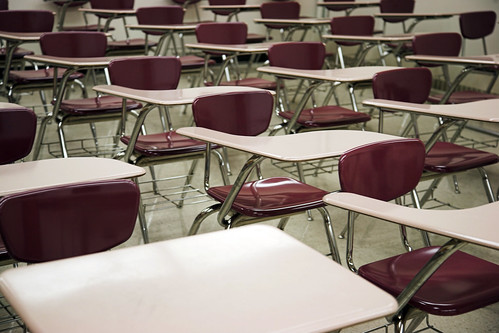 After revisiting Dean Shareski's interview with Clarence Fisher, I've found myself thinking about how the layout of a classroom speaks loudly about the types of learning activities that take place within the space. Just as a restaurant has tables arranged for intimate conversation; a doctor's office has chairs arranged for private contemplation; and an auditorium focuses attention on a public performance; your classroom is arranged for.... what?
After revisiting Dean Shareski's interview with Clarence Fisher, I've found myself thinking about how the layout of a classroom speaks loudly about the types of learning activities that take place within the space. Just as a restaurant has tables arranged for intimate conversation; a doctor's office has chairs arranged for private contemplation; and an auditorium focuses attention on a public performance; your classroom is arranged for.... what?While we may be stuck with the rigidity of the desk, the layout of a classroom is largely left up to the inspiration of the teacher. In organizing their classroom furniture, I wonder how many teachers consider arranging their desks to maximize the effectiveness of collaborative experiences. My suspicion is that many teachers, in the name of 'classroom management' arrange their rooms to minimize opportunities for interaction.
With that, I'm venturing to share two distinct desk layouts that I use in my own teaching:
The first is the adaptable, double horse-shoe: The inner circle and outer circle allow students to participate in discussions with the entire class, or to focus on a large group activity/speaker/presentation. When the inner desks are rotated 180 degrees to face the outer horseshoe, you have instant tables formed that can be used for partner work, or small group activities.
The second simple group organizer I've used I call the 'awk-quad': Each quad is comprised of four desks, clustered, with two desks facing one another, and the other two facing in a common direction, but sandwiched onto the side of the opposing desks. Though awkward, this grouping allows for group discussion or partner work and with limited stress on student necks, provides a clear line of sight to centralized classroom activities.
Care to share your desk/classroom arrangement?
 Although I feel guilty about asking the audience to participate... I think that learning should be conversational, so I'm inviting educators to share photos and rationale for the arrangement of their classrooms. Simply post a sketch or photo of your learning space on Flickr, or on your blog, and give an explanation of why your learning space is so designed.
Although I feel guilty about asking the audience to participate... I think that learning should be conversational, so I'm inviting educators to share photos and rationale for the arrangement of their classrooms. Simply post a sketch or photo of your learning space on Flickr, or on your blog, and give an explanation of why your learning space is so designed. In sharing your 'intentional workspace arrangement', you can link back to this post; or you can use the comment space below to link out to your photo and explanation. Who knows? This could be even become a meme of sorts...
Sue Tapp's response to the interview noted above, reminds me that VoiceThread offers an effective way to share a classroom story:
The Teacher 2.0 Podcast that spawned this idea is now available.
Photo credits: Piero Sierra; dc John




6 comments:
I share a picture but I am out of school for training until Friday. With the exception of a couple of teachers that have big tables(and I think all of them actually have dividers in their room that get put on the table to separate kids) there are two rooms in the school that are not set-up in rows. One has a big horseshoe(big room!) and the other small room(mine!) is in the double horseshoe. Wow...never really thought about that--amazing out of 36 rooms--there has got to be another one somewhere!
I love the double because with the small aisle in the middle in three steps you are three feet away from every desk in the room.
Ahh...knew I should have proof read before publishing--error within the first two words.
I had a professional development and had to sit for three hours in a third grade seat:
1. I don't know how kids sit in those desk, maybe they would be more comfortable if we hit with bamboo
2. Teachers can not be trusted during computer workshops
3. I waited for my soft return for three hours....it never happened
I also think we need to look at other things in our classroom design than desks. I have a couch in my room, a bunch of plants, etc. I would love to have ways to separate the room more into different spaces and allow kids more room to work by themselves or with others, etc as they choose but I am restricted by the size of the space I have to work in. There are a lot of very cool office and studio designs out there and I am constantly on the look out for pictures of office interiors and studios.
This post actually got me thinking about something else, which is how we arrange our electronic classroom workspace. Are our online classrooms welcoming with images and places for collaboration? How much of our online arrangement is dictated by html (sort of like being limited in the classroom by the placement of a whiteboard or chalkboard)? What does our online workspace say about our content & approach?
Interesting post, as always! Will listen to the podcast on my way home today.
Brian,
More teachers should have to sit in student desks... talk about motivation for change!
Clarence,
The atmosphere of a classroom is indeed so much more than the default desk. My favourite tone-setting component was a 'serious' stereo with rich quad sound.
Kelly,
The whole idea of designing spaces is resulting in interesting 'defaults' in the online world. The locations of search components, menus and other page elements seems to be follow the leader. Mind you, such commonalities likely save netizens small amounts of time, many times each day. Have you ever used Adobe Connect to set up a custom online classroom? Rich environments are possible in evolving conference tools!
Post a Comment